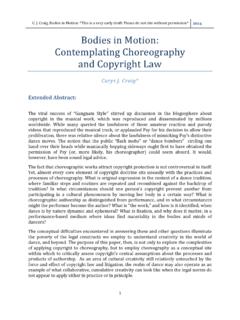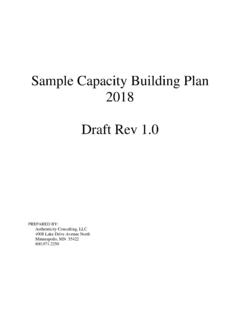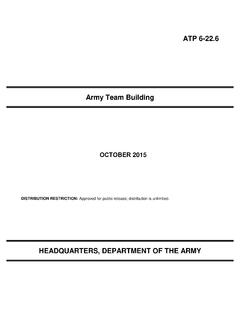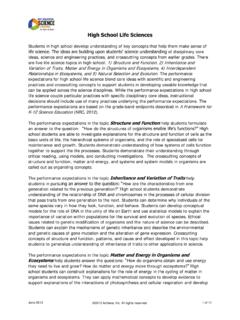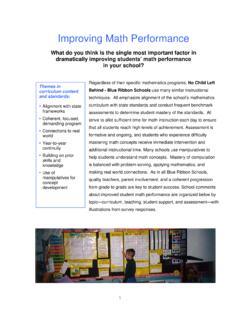Transcription of CHAPTER FIVE Unit Cohesion and Military Performance1
1 137 CHAPTER FIVEUnit Cohesion and Military Performance1 OverviewIn the years immediately after World War II, several scholars argued, based on infor-mation collected from German and American soldiers, that unit Cohesion is essential to Military effectiveness. Their conclusions gained considerable influence within the Military . As we discuss below, our understanding of the concept of Cohesion and its relationship to Military performance has evolved in the years since, but the importance of the general concept of Cohesion remains widely appreciated in the is little doubt that personal bonds can play an important role in combat motivation. Understanding the full meaning of the term Cohesion , what influences it, how it relates to performance , and how changes in group composition affect it is central to understanding how the introduction of known gay men and lesbians into Military units will impact Military performance .
2 In the debate preceding the 1993 enactment of legislation leading to the DADT policy, there was a difference of opinion among Military social scientists as to the likely effects of lifting the ban. Some predicted that the presence of known gay personnel would significantly disrupt unit Cohesion , while others disagreed. Accordingly, RAND s 1993 report included a review of the existing literature related to the nature of unit Cohesion , its effects on Military performance , and the ways in which the presence of known gay men and lesbians might affect Cohesion and CHAPTER provides an update on relevant research on these topics and discusses new topics raised in the literature since 1993. As in 1993, we focus on the Cohesion - performance link because it is so central to the policy debate indeed, it is specifically cited in the DADT legislation.
3 But Military doctrine has long recognized that unit readiness and performance are the products of an array of inputs, policies, processes, and intangible factors in addition to unit Cohesion , including leadership, training, mis-sion, equipment, and logistical support, as well as weather, terrain, and enemy char-1 This CHAPTER was prepared by Robert J. MacCoun and William M. Sexual Orientation and Military Personnel Policy: An Update of RAND s 1993 And, as discussed in 1993, Cohesion is similarly influenced by a variety of factors, including leadership, group size, and unit turnover (RAND, 1993). Perhaps the most significant addition in the current study is a review of the rapidly growing literature on how heterogeneity among group members affects Cohesion and task per-formance. We also attempt to clarify the important role of interpersonal trust in one s colleagues, showing that it is produced by the nexus of professional role expectations and situational demands during threat and does not require established bonds of liking and ApproachAs in 1993, we conducted an extensive literature search for new empirical studies on group Cohesion (or cohesiveness) and its antecedents and consequences, locating a considerable body of new research, including both published and unpublished stud-ies in the Military , sports, social psychology, and industrial-organizational behavior literatures.
4 Because our coverage is so broad, we limit our focus mostly to quantita-tive studies that measure Cohesion , performance , and related variables at the individ-ual or small-group level. Thus, our review does not include most qualitative studies, organization-level case studies, or essays that discussed DADT and its relationship to unit Cohesion without direct measurement at the individual or small-group of the relevant empirical evidence takes the form of correlational evidence, including factor analyses, multiple regression analyses, and meta-analyses. In brief, factor analysis is a technique for attempting to infer the underlying dimensions in questionnaire responses. Multiple regression analysis examines the pattern of associa-tions between an outcome variable and a set of predictor variables; it attempts to sta-tistically distinguish these predictors in situations where experimental control is not feasible.
5 And meta-analysis is a technique for aggregating and synthesizing different empirical estimations of an association ( , between task Cohesion and performance ) across multiple studies; it can provide more reliable estimates than would be possible in any single study. In our discussion, we attempt to minimize the statistical details (which are available in the studies we cite), except where a technical discussion is neces-sary in order to critically review a study or to clarify its DoD requires all services to regularly assess and report on the readiness of deployable units according to a highly specified readiness reporting system (DoDD , June 2002). Unit Cohesion is not among those readiness factors required to be assessed. See, for example, Army Regulation 220-1, 2010, CHAPTER 9, and Air Force Instruction 10-201, 2006, CHAPTER 3.
6 In addition, the Cohesion concept is not always central in the small-group and organizational behavior literatures. For example, Salas et al., 2007, display seven different theoretical models of team effectiveness dating back to 1978, and Cohesion does not appear in any of the model diagrams, though many related concepts leadership, communication, interdependence, heterogeneity appear in most of Cohesion and Military performance 139We begin by reviewing the measurement of Cohesion and its effects on group performance and other relevant outcomes. We then turn to an examination of what is known about the effects of heterogeneity in member characteristics (sexual orientation, race, gender, etc.) on group Cohesion and on group performance . Finally, we discuss the implications of these literatures for the debate about the repeal of the DADT : Understanding Unit CohesionWhat Is Cohesion ?
7 Early Military writings discussed Cohesion in monolithic terms as an important contributor to Military performance and winning on the battlefield. Further academic inquiries into Cohesion have distinguished various types of Cohesion as a means to better analyze how interpersonal dynamics impact the performance of small organizations , teams and small Military units, such as squads and platoons. Since the 1993 study, further evidence has accumulated to support distinguishing between task and social Cohesion , and this distinction is now adopted in most academic articles on the topic (Beal et al., 2003; Carless and de Paola, 2000; Carron and Brawley, 2000; Casey-Campbell and Martens, 2009; Chang and Bordia, 2001; Chiocchio and Essiembre, 2009; Cota et al., 1995; Dion, 2000; Kier, 1998; Mullen and Copper, 1994).
8 Task Cohesion and social Cohesion are defined as follows: Task Cohesion is the shared commitment among members to achieving a goal that requires the collective efforts of the group. A group with high task Cohesion is composed of members who share a common goal and who are motivated to coor-dinate their efforts as a team to achieve that goal. Social Cohesion is the extent to which group members like each other, prefer to spend their social time together, enjoy each other s company, and feel emotionally close to one argues that the conceptual distinction between task Cohesion and social cohe-sion that has emerged independently from several models and lines of research is an important milestone in Cohesion research (Dion, 2000).If repealing DADT were to lead more gay service members to disclose their orientation to other unit members, the effects on task Cohesion and the effects on social Cohesion would not necessarily be the same.
9 Therefore, throughout this CHAPTER , we will elaborate on the interpretation, antecedents, and consequences of these two types of Cohesion . But we also highlight several other terms that will be relevant to this Cohesion Versus Vertical Cohesion . Task Cohesion and social cohe-sion are both forms of horizontal Cohesion , which refers to Cohesion at the primary 140 Sexual Orientation and Military Personnel Policy: An Update of RAND s 1993 Studygroup level generally the crew or squad, and perhaps the platoon rather than at the level of larger units, such as the brigade, company, or service (Griffith, 1988; Siebold and Kelly, 1988). In contrast, vertical Cohesion refers to downward or upward Cohesion involving leaders and followers. In the remainder of this CHAPTER , we will reserve the word Cohesion for horizontal Cohesion , and we will use the more familiar terms leader-ship and followership (conventionally used in organizational studies) when discussing vertical Pride, Collective Identity.
10 Group members often describe feelings of pride and identification with their group as an entity, and this can occur even though they are unacquainted with many, if not most, of the other group members (Swann et al., 2009). Further research is needed to determine whether this sense of group pride should be subsumed into either social Cohesion or task Cohesion , but for present purposes we will assume it is a distinct factor in its own right (Dion, 2000; Griffith, 2009; Hogg and Terry, 2000; Manning, 1994; Mullen and Copper, 1994; Shamir et al., 2000).Morale and Esprit de Corps. Unit Cohesion can be considered a contributor to morale. Manning reviews various definitions of the terms morale and esprit de corps and suggests that morale is best thought of as the enthusiasm and persistence with which a member of a group engages in the prescribed activities of the group (Manning, 1994).
